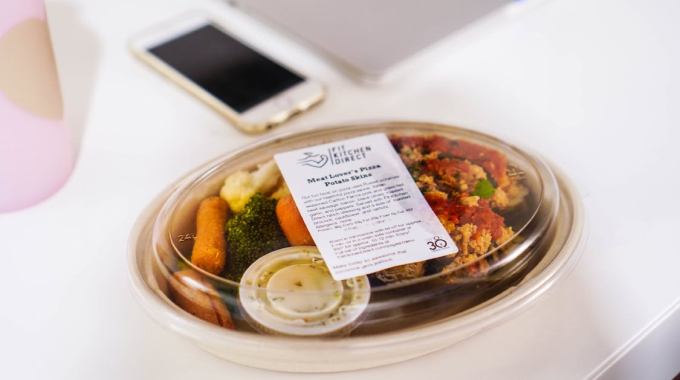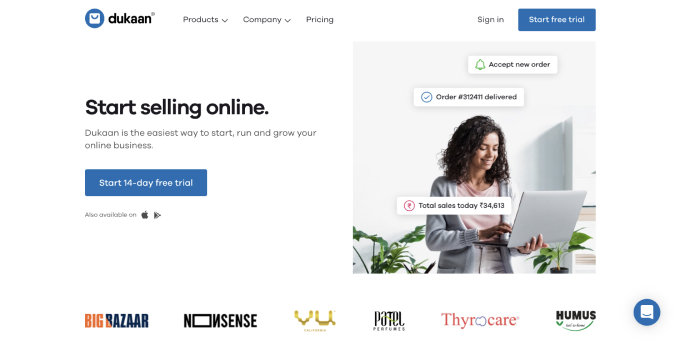This one’s for all those masterchefs and food enthusiasts who are thinking about starting their own food business! If you want to learn how to sell food online, tag along with us as we discuss all the important steps of setting up your own food business.
The value of the global food market is predicted to be a staggering $12.24 trillion in 2021. According to Statista, the American food and beverage eCommerce sector generated 34.2 billion dollars in revenue in 2021. This represents an increase from 2020 of about 8.2 billion dollars. And this amount will increase to 47.6 billion US dollars by 2025.
The number of smartphone users has increased, which has boosted global sales of food and beverage (F&B) products online. Due to the growing popularity of smartphones, which are primarily used for shopping online, there will be a rise in consumers purchasing food and beverages online. Isn’t it time you had a share of the action?
Well, you can now! It’s now simpler than ever to sell food online, thanks to international marketplaces and eCommerce platforms.
We’ll guide you through everything, from understanding international food laws to selecting the best platform for your business to advertise your goods. By the time you finish reading, you’ll be able to put everything you’ve learned into practice and open your exclusive online store, in addition to having a thorough understanding of how to sell food online.
Let’s move on to the main course and learn how to turn your dream into a reality now that the entrée is over.
The Rise of Ordering Food Online
COVID-19 has changed the way customers make purchases, and as consumers have gotten accustomed to the ease of online shopping, its influence is anticipated to last for a long time.
In a Gallup poll, 72% of consumers said they preferred the online food option because they didn’t want to leave the comfort of their homes, while 41% said they simply wanted to stay indoors because of the uncomfortable weather.

Manufacturers and wholesalers should be conscious of these disruptive tendencies in a customer-driven sector and take advantage of them by obtaining a faster time to market for their goods.
In addition to offering fantastic bargains and discounts, online food stores are increasing choice and convenience for customers by enabling them to place orders with just a single tap on their smartphone.
As a result, the food delivery industry is quickly catching up in markets in the Middle East, America, Asia, and Europe. Busy work schedules and the high-income levels of individuals who rarely have time to prepare their meals at home are the key factors driving the US food delivery sector.
7 Easy Steps to Sell Food Online (+6 Marketing Tips)
1. Identify your target audience and decide what food to sell online
If you’re intending to sell food online, try to choose a niche because it will help you build a solid clientele. You must take your target audience into account when determining your niche. Food is a tremendously diverse market, and assuming that every individual is your customer will not help you please them. We have curated a list of some food-based businesses that you could start.
Therefore, before moving further, you must choose your target audience. For example, the food list you will offer for the younger crowd is unquestionably different from the list for children. Therefore, you must pick which categories of clients you will accept.
Then you can research popular food trends like plant-based diets, vegan goods, and artisanal food items. Several niche choices include:
- Customized desserts and exotic meals
- Fair-trade, natural, and organic foods
- Food prepared to meet dietary requirements (gluten-free or dairy-free)
- Artisanal, small-batch, and fine foods.
- Religious and ethical foods (vegetarian, vegan, kosher, and halal)
After determining your target market, you must decide exactly what you would like to sell. You might either sell food that you make yourself or act as an aggregator and get it from different suppliers. The former enables you to manage every part of the business, from the cost of production to your profit margins, while the latter enables you to sell a greater variety of food goods.
If you’re just starting off selling food products online, it can be preferable to concentrate on products that don’t demand significant investment. Look into simple, first-time food enterprises that need little startup capital, equipment, little shipping, and no permits. Consider:
- Candies
- Packaged foods
- Pickled and canned goods
- Dried plants
- Kits for baking ingredients
- Seeds
- Raw materials (flour, etc.)
- Curated food items
- Tea and coffee
2. Know your local laws and license requirements
Before you can seriously consider launching an online food business, you must be aware of the regulations in place. Your clients will be in danger if you make a mistake with anything related to the food you are selling (including your package or ingredient list). If you don’t adhere to the proper regulations, you could also face significant fines.
No matter if you want to cook in your house or in a commercial establishment, you must get familiar with the rules that apply in your area. Anyone in the US who intends to sell food online must abide by the “Cottage Food Laws” It means that you need to understand proper food storage techniques and safeguard your food from any harmful contaminants like pets.
You must conduct supply chain research if you choose to outsource the handling of your food and sell it online through a provider in order to ensure that your ingredients are of top-notch quality.
You will also require:
- An official business license
- Permits and zoning approval from your government.
- Kitchen inspections should be performed once a year.
- To maintain food safety, hold frequent training sessions for proper food handling.
- Your chosen state must provide a business license. The SBA website has a form for this.
Learn about the rules and restrictions your area has in place for the management and sale of food. We advise reading through the Cottage Food Laws website thoroughly to obtain more information relevant to your state.
3. Find a supplier
You’ll need a dependable source whether you’re creating food items from scratch or picking products to market to your audience. In the food industry, picking the right supplier is crucial. Making the wrong decision could damage your brand and give your customers food poisoning and other illnesses.
When planning to sell food from home, be careful to exercise due diligence. Spend time reading through customer reviews before choosing a supplier and making your purchase decisions. Look for clearly established supply chains and a plethora of details about the origins of your products from your suppliers.
If you’re searching for a supplier with certain credentials (such as ingredients from sustainably derived sources), get in touch and request extra information if you can’t locate proof of those facts online. Any reliable supplier ought to be able to give you the details you need to feel at peace.
Make sure your vendors can provide you with goods that have a respectable shelf life so you don’t send out food that is about to expire. By properly organizing your inventory, you can also improve the chances of keeping your food fresh.
When you look for a supplier, bear the following in mind:
- Costs of manufacturing
- Grade of the raw materials
- Delivery and shipping times
- References and testimonials from former clients
- Communication and material accessibility
4. Price your food products
Pricing your products is always a slippery slope, especially in an industry where there is no set method for determining food product prices. Regardless of how tasty your treats are, they must be priced properly to sell.
Coming to the main point: how to determine whether you are underselling or overselling your products?
One good way to go about this is to bifurcate your costs into fixed and variable costs. Your fixed costs will include calculating the cost per item by taking into account ingredient prices, manufacturing expenses, cost of labor, and manufacturing is the only method to ensure that your pricing is accurate.
Variable costs will entail accounting for costs like equipment for cooking, storage rental, insurance, license fees, and personnel compensation etc. To ensure that your company at least breaks even, each of these needs to be taken into account.
You also need to decide your profit margin and add it to the above costs so that your business can generate some revenue. Generally, a 10% margin is regarded as average, and a 20% margin as high. However, different industries have different optimal net profit margins.
Alternatively, look into your rivals’ pricing strategies. It’s a good idea to keep your prices in the same ballpark since this could aid in spreading the word and building your brand.
One gentle reminder here: None of these costs are set in stone. As and when required, you can fine tune your prices to evaluate what works better for you. It will take a lot of trials and changes to find your footing in when setting your prices.
5. Branding, packaging, and labeling
It is said that you “eat with your eyes first”. Ensuring your food reaches the customer neatly packaged and damage-free creates half the impression on the customer’s mind. Thus, it is essential to put in great thought into your branding and packaging strategies.

Below are some pointers that will help you traverse this crucial step easily:
Branding
For branding purposes, a brand name should be chosen first. Your customers can comprehend the purpose of your brand with a name that complements it! Consequently, your company’s name has a big impact. The proper name not only engages with customers but also enhances the productivity of your business.
Before engaging in any business promotion, you must choose an appropriate company name. Remember, your branding should be a reflection of the services you offer and the target audience. Pick a brand name that’s catchy and easy to remember.
When you wish to sell food products online, you need to justify your excellence and the reasons why buyers should choose your product. These duties can be performed easily and swiftly with the right branding.
Additionally, branding can increase consumer recognition of your company by creating a visually appealing logo that serves as its interpretation.
Brand colors are also important as a strategy for effectively displaying your business. Since a customer will first notice your brand’s color when they interact with it, the color of your company can make an impression on them.
You can also convey your feelings and emotions to your target audience by using the color of your brand.
Packaging
Any business needs to have strong branding, but when starting an online food business, the packaging is especially crucial. Putting plenty of time and money into strong, long-lasting, and product-appropriate packaging is worthwhile.
Customers are more likely to adore the finished product if they like what they find on your website. Because it is so important, consider getting professional and experienced designers to design the packaging for your food products.
They can help you choose the right color scheme, typeface, shape, and material, making sure that everything works together to create a package that looks good and serves its purpose.
Labeling
Aside from the aesthetics of your package, each nation has specific rules on labeling, which may include country of origin, nutritional data, allergen warnings, and best-before dates. The FDA food ingredient and packaging guidelines illustrate the type of details you must provide to aid customers in making informed decisions regarding their purchases.
The following information should always be present in your food labels:
- Complete list of ingredients.
- Quantity and net weight of the packaged food.
- The name of the supplier.
- Your company’s name.
- The best before/ expiry date.
- Highlight common allergens.
- The nutritional and the calorific content of the food.
6. Prepare content for your online store
Similar to branding, the aesthetics of your store play a crucial role in persuading customers to purchase food items without first tasting them. Here are the many content types you ought to create for your online food store.
Product images
Initial impressions matter and your product photos are a customer’s first point of interaction with your food. You have the option of DIY-ing your picture sessions or hiring a photographer with expertise in properly styling and photographing food.

To capture the texture and accurate colors, photograph the product and its packaging in-close detail, but also try lifestyle photography that offers to serve and pairing suggestions. This can assist in getting your food off of your store and into a customer’s shopping cart.
Product descriptions
Detail-rich product descriptions that expressly explain the flavor and the texture of the food you offer are necessary as well as effective in turning your online store visitors into customers. Leave no room for uncertainty. Keep in mind that a skeptical customer does not make a purchase.
Keep your product descriptions concise and brief. Try to provide value to the customers in them and make sure to include any additional information that you’d want them to have.
Basic pages
You should include the following fundamental pages on your eCommerce website:
- Homepage: It is the very first page that potential buyers who are searching for your website will see. Make sure it’s clean, simple to use, and accurately reflects your branding.
- About Us page: This page should explain the background of your brand’s origins, its core principles, and what makes it unique and special.
- Contact us page: Include your address, cell phone number, and email address. Or add a contact form to your website to make it simpler for clients to contact you.
- FAQs: Customers frequently have inquiries about shipping details, postage costs, and specifics of the commodities you sell. These inquiries are answered on this page.
Structure product pages
Your eCommerce store’s product pages are its beating heart. Customers will learn what you sell there before deciding whether to make a purchase or simply exit the store.
Product pages that convert well contain excellent images, thorough descriptions, call-to-action (CTA) icons, and clear pricing and delivery details.
7. Create your online store
At this stage, it is time for you out all of your planning into motion: by creating an online store for your business.
An online presence is necessary for all small businesses. Once you have an internet store, selling food online is simpler. This is crucial to both attracting customers and streamlining the work you’ll be doing as an entrepreneur.
There are various options to choose from when selling food online. You can launch your own eCommerce store, build your online store on a marketplace or with a website builder.
Let’s take an in-depth look at the pros and cons of these alternatives:
Marketplaces
Online marketplaces like Amazon, Etsy etc. are preferred by people as they come with an already established audience base. There’s not much effort needed in terms of getting started or store customization.
But solely running your eCommerce store on marketplaces is not ideal. You will have to compete with multiple sellers on the platform and creating a brand identity for your business on marketplaces is nearly impossible.
Marketplaces are good for people who want to sell quickly or are testing out new products. They are also good as a secondary sales channel.
Website builders
There are many website builders like Wix, Squarespace etc. that are great for creating aesthetic looking and functional websites to run your online bakery. These website builders also take care of the maintenance and updation themselves, thus freeing you to focus entirely on selling.
However, there are downsides to selling over a marketplace as well. Most of these website builders require prior coding and design experience and come with a steep learning curve. Additionally, though most of these websites are aesthetic-looking, they often lack the advanced eCommerce platform needed to scale a business.
Your own eCommerce store
The best way to transition into selling online is by creating your own eCommerce store. Dedicated eCommerce platforms contain all the functionalities that are needed to efficiently manage and scale your business.
It won’t be necessary for you to compete with other sellers once customers start coming, unlike on a marketplace. You can also customize the look and feel of your shop and are immune to changes in the platform’s algorithms, something which is always a risk on social media platforms.
With eCommerce platforms, you can easily incorporate blogs and integrate your social media handles with your store to draw clients from all over the internet.
You can use Dukaan to create an online store that’s both easy to use and appealing to your audience. You do not need any coding skills or designing experience to create a Dukaan-powered store.

Dukaan comes equipped with advanced eCommerce functionalities, business tools and plugins to automate the manual and repetitive business processes, allowing you to sell your products more efficiently.

Launch, scale and manage your online business with just $14.99 on Dukaan. Annual plans start at $149.99 only.
Suggested themes for online food business:
- Lightspeed – Preview the Lightspeed theme.
- Leo – Preview the Leo theme.
8. Market your food business

Once your store and brand have been established, it’s time to market your business. A multi-channel marketing strategy will produce the best outcomes for the majority of firms. Here are some practical suggestions for promoting your internet food store:
Word of mouth
Tell your family and friends to tell others about your business and the goods you sell. One of the rudimentary methods of marketing, it is still useful.
Social Media
Social media marketing has huge potential for marketing your business. You can advertise your goods and services when you start a food business using a variety of social media sites, including Facebook, Twitter, and Instagram.
Twitter acts as every food entrepreneur’s closest friend and is essential for building brand exposure. Additionally, you can advertise your food products on Facebook and Instagram, which can increase customer interaction with your brand.
These social networks not only boost the legitimacy of your company but also guarantee a stronger connection with the target audience. The more you interact with your audience, the more comfortable they feel associating with your business.
Special events
Another great way of creating awareness about your business is by holding photo and food review competitions, planning a culinary class, or taking part in different food festivals to get your business noticed by the masses.
The more places you can advertise your business, the better.
Email marketing
Not all your intended audience might be on social media, but it is guaranteed that all of them have access to email.
Email marketing is the best way to connect with your audience on a one-to-one level. You can leverage email marketing to share promotions and deals with your customers, create buzz about new additions to your shop and share behind-the-scenes anecdotes about your business that humanizes it.
There are various tools to track the effectiveness of your email newsletters that you can use to optimize its opening rate.
SEO
Nobody will get to know about your business and how great your products are until they see. And how do you do that? By utilizing SEO marketing.
Your webstore should be optimized to rank highly on search engine result pages (SERP). Following SEO best practices will greatly improve the organic traffic for your online store.
Maintain a regular blog, conduct keyword research, collect backlinks, and enhance the functionality of the website.
Here are some other key points that you should take care of:
-
- Use relevant keywords in meta titles, headings, product descriptions etc.
- Optimize your site for loading speed and mobile responsiveness.
- Write enticing meta descriptions for your blogs.
- Include tons of quality backlinks to establish your domain authority.
Pay-per-click ads
You only get paid in this advertising approach when people click on your ads. The most well-known ad platform is Google Ads, which can show your ads on the websites of its partners and the Google Display Network.
Influencer Marketing
Influencer marketing is a useful strategy for promoting your food products. Similar to Instagram, YouTube, and Snapchat, this procedure is a form of social media marketing.
Using this tactic, you may advertise your company on social media, through reviews, or through food bloggers. Additionally, you may use the assistance of food bloggers to market your food products, which will be very beneficial for your company.
Conclusion
There is always room for new firms in the food market. With rising competition and increasing demand, it’s a good idea to learn how to sell online and capitalize on eCommerce.
Follow the steps outlined above to witness your food business thrive. You’ll create a profitable food company in no time if you have the appropriate information and do not shy away from working hard.
FAQs
1. What are the advantages of having an online food store?The most significant advantage of having your own online food store is that you have complete control over the presentation, marketing and branding. Second, selling with your custom store helps brand building and customer management. eCommerce platforms like Dukaan make it easy, convenient and economical.
2. Can you make food at home and sell online?
Yes, you can make food at home and sell it online. However, what homecooked food you can sell online is subject to the local laws and regulations where you live and where you plan to sell it. Have a professional inspection done and have all the necessary paperwork and equipment ready before starting a home food delivery business.
3. How should food products be priced?
Many factors come into play when it comes to pricing your food products. Market analysis, demand, and comparison with competitors are essential for deciding on a pricing point. Additionally, compute your producing and selling costs along with other charges like marketing, shipping etc. Due to the variable nature of many of these factors, you can keep switching rates as needed.
4. How do I start an online food business?
Starting your food business is more about strategizing than actual selling! Determining what you can sell, figuring out the logistics of ingredients or the products, finalizing suppliers, choosing branding and securing logistics and shipping partners are the parameters you need to sort to start your online food business.
5. Do I need a license to sell homemade food?
Yes, since food is subject to contamination and can pose a health risk, there are checks in place to ensure its quality. Commercially selling food requires a state business license. You’ll need to obtain one for your brand by passing a health inspection and meeting the regulation standards.


Leave a Reply
You must be logged in to post a comment.